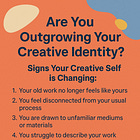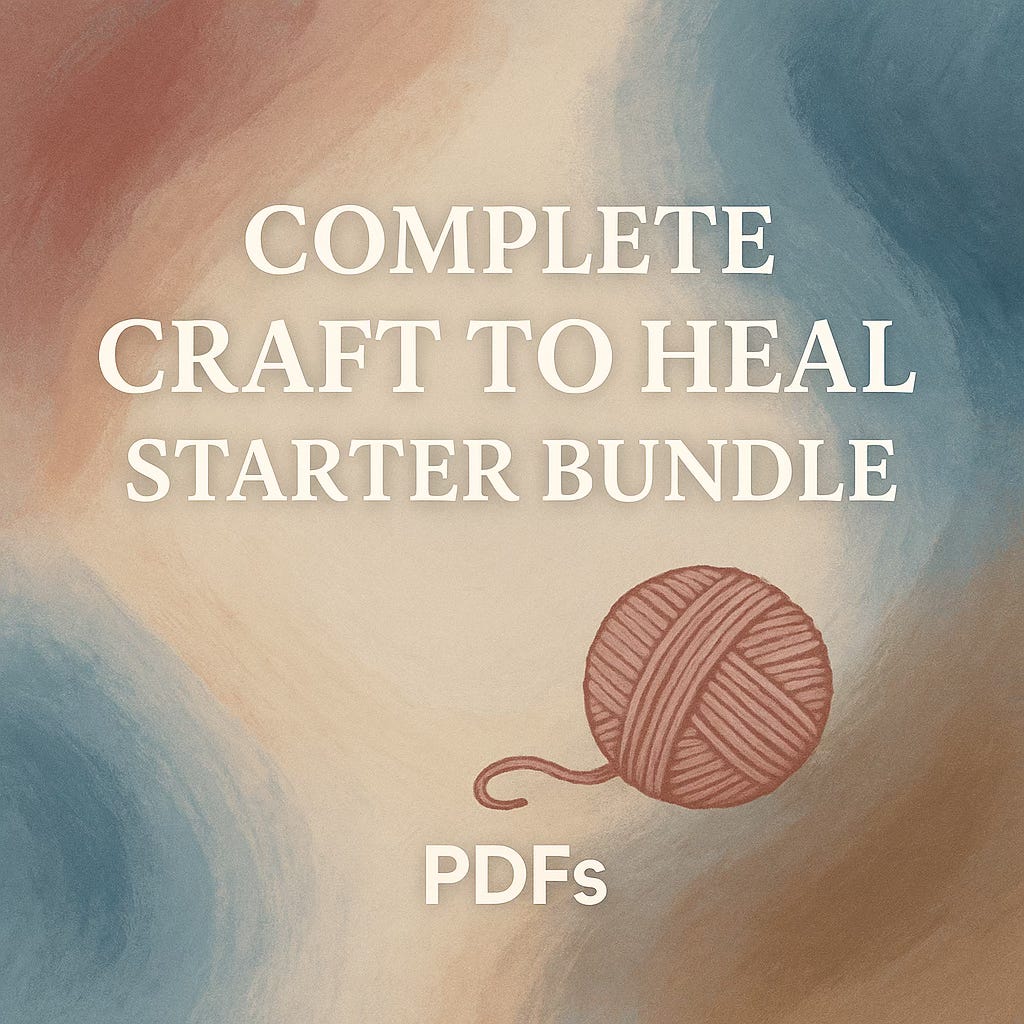Soothing the Nervous System with Stitches: Why Medium Matters
In fiber arts especially, medium choice is not just about what we want to make. It is about what we need to feel.

There is a moment, if you’ve been crocheting for a while, when the rhythm takes over. Your fingers know what to do. Your breath slows, your shoulders drop, and for just a moment, your nervous system seems to exhale. This is more than just the pleasure of making something. It’s something deeper than that. It is a felt experience of restoration.
In my work exploring the intersection of mental health and creative practice, one of the core questions that I look at is:
How do the materials we choose shape our inner world?
The answer is neither entirely psychological nor purely aesthetic. It lives somewhere in the tactile, sensory, and symbolic relationship we build with our medium. And in fiber arts especially, medium choice is not just about what we want to make. It is about what we need to feel.
Medium as Medicine
Different crafts offer different forms of somatic support. For some, knitting’s repetitive motion mirrors breath and heartbeat, encouraging a kind of meditative state. For others, crochet’s looping structures provide the tactile satisfaction of containment and release. Hand quilting may bring the soothing of hand to fabric pressure. Weaving might offer visual order amid emotional chaos. These aren’t aesthetic preferences alone. They are bodily languages, fluent in the nervous system’s needs.
When we talk about mental health and fiber art mediums, we’re not only talking about comfort or distraction. We’re talking about regulation. The nervous system, particularly in people with anxiety, trauma histories, or chronic stress, often craves sensory input that is rhythmic, predictable, and responsive. Fiber arts meet that need.
Neuroscientific research into bottom up regulation, where the body informs the brain rather than the other way around, tells us that touch, rhythm, and visual engagement can downshift the nervous system from fight or flight into a more parasympathetic, restorative mode. In simpler terms, how craft choices soothe the mind is not a metaphor. It is a biological reality.
Crochet and Emotional Regulation
Of all the mediums I’ve worked with, crochet is the one I return to most often when my bodymind is frayed. Crochet for emotional regulation is not a stretch of language. It is the best description I’ve found for what actually happens. When anxiety floods my system or when depression pulls me into stillness, the physicality of crochet gives me something tangible to hold.
The twist, the tension, the slight resistance of the yarn … There is something about the loop structure of crochet, the way it builds from nothing, that makes it feel uniquely suited to those moments when I feel undone. Unlike knitting, where dropped stitches can unravel a row, crochet allows me to work without fear of collapse. It is, in this way, a deeply forgiving medium.
I’ve heard this echoed in interviews with other fiber artists. They tell me that they just need to make squares, not quilts, or rows, not scarves. They tell me that the rhythm of stitching is like a metronome for the body. These aren’t hobbyist statements. They’re articulations of survival strategy.

The Politics of Choice
It’s important to say that medium choice is never just about aesthetics or convenience. For those of us navigating disability, neurodivergence, or chronic mental health conditions, choosing a medium is often a political and embodied act. It is a refusal to perform productivity in a way that burns us out. It is a turning toward what soothes rather than what sells.
In the broader world of contemporary craft, there is often pressure to master multiple forms, to commercialize quickly, or to present one’s work with a polished narrative arc. But these expectations can ignore the very real relationship between a maker and their materials — a relationship that might change depending on energy levels, flare ups, cognitive load, or emotional overwhelm.
Mental health and fiber art mediums belong in the same sentence not because we need to pathologize our creativity, but because acknowledging this link frees us to work in ways that are sustainable. The softness of the yarn, the feel of the hook in hand, the pace of the pattern are all part of a system of care. When we let go of external expectations and tune into what our nervous systems actually want, we are choosing creative survival.
An Exercise: Material Memory Map
If you’re unsure what your body is asking for creatively, try this:
List five materials you’ve worked with recently (for example, cotton yarn, wool roving, bamboo hook).
For each, write down how it made you feel: physically, emotionally, energetically.
Were there textures that calmed you? Tools that frustrated you? Movements that grounded you?
Circle the one that felt most like an exhale.
For your next project, let that be the anchor. Even if it’s small. Even if it doesn’t go anywhere.
This isn’t about tracking productivity. It’s about noticing what the body remembers.
Final Thoughts
How craft choices soothe the mind isn’t a side conversation. It’s central to understanding how we heal, cope, and continue to make art in a world that often undervalues slowness.
Whether you’re working with delicate laceweight cotton or chunky wool, each decision is a dialogue with your nervous system.
The beauty of fiber arts is not just what they produce, but what they allow: rest, rhythm, regulation. Let yourself choose the medium that meets your mind where it is. Let your art be not just expressive, but supportive.
And if you're curious about how to deepen that relationship with your practice, my work includes one on one sessions where we explore how to align your creativity with your current needs, not your old expectations. There is no right way to stitch your way home to yourself. But there are gentler ways. Let's find them together.
If you got this far, perhaps you like my work. The work takes work. Support it if you can:
You Might Also Like to Read:
You Might Also Be Interested In:
Complete Craft to Heal Starter Bundle
This 4-guide bundle (80+ pages) includes space design principles, sustainable practice rhythms, the science of craft benefits, and guided journaling prompts.







This post, and the sequence it's part of, really made me stop and think about the different media. I love how you talk about the difference between knitting and crochet - how there is the peril of losing a whole row of knitting. Yes. I've felt that too. I've thought about why I enjoy quilt piecing so much. Why take a perfectly fine pieces of fabric, then hack them up? Recreate a new express in putting them back together. I really enjoyed thinking about the metaphors to play with while reading this post.
Thank you for your writing. It's always worth the time to go back and savor reading, even if I'm running a month or two behind. xox
Reading this has helped me to understand why I have had to frog a project 3 times already and left it on the Naughty Step for now. I’m not doing great mentally at the moment, and the fine yarn and new techniques needed are just too much. It also explains why I’ve gone back to my scrap yarn blanket and shawl - they are comfort projects!
Thanks for this. I hadn’t realised what I was doing until you laid this out, but it does make sense.